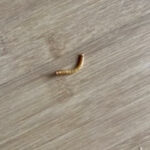
A reader recently asked us, “How did my catalpa tree get worms on it?” She explained that she never put any worms on the tree, she just planted it and a few years later the worms appeared. Although she didn’t explicitly say so, we believe the “worms” she is referring to are catalpa worms. Catalpa trees and catalpa worms have a very interesting relationship that we will explain below.
Catalpa worms (also known as catawba worms since the words “catawba” and “catalpa” are interchangeable) are not technically worms, they are the larvae of sphinx moths, which makes them caterpillars! These caterpillars are generally known for two things. First, they are tenacious eaters and their only food source are the leaves of catalpa trees (a.k.a. catawba trees.) Many people with catalpa trees on their properties also find catalpa worms. While some people worry about how catalpa worms completely defoliate the trees, there actually isn’t anything to worry about. The trees and the caterpillars have a good relationship! A catalpa tree offers a food source for a group of catalpa caterpillars and the caterpillars’ dung helps fertilize the soil around the tree! Even though the caterpillars might eat all of the leaves on a tree, a healthy catalpa tree is resilient and should bounce back! And to clarify further, catalpa worms only feed on the leaves of healthy catalpa trees, so any tree being eaten should be fine. Some people even grow catalpa trees for the sole purpose of attracting catalpa worms, which leads us to the second thing these caterpillars are known for. Catalpa worms make fabulous fishing bait! This is because of their tough skin, which prevents fish from being able to just snatch them off the hook. They are so popular that fishermen might special order them, or even plant catalpa trees in the hopes of attracting a colony of worms!
Now on to our reader’s concern: Why did her tree suddenly attract catalpa worms? Much to the dismay of the many readers who write to us asking how to attract catalpa worms to their trees, we don’t have an answer for her. Catalpa worms always choose healthy trees, but other than that, we don’t know why some catalpa trees are brimming with catalpa worm populations and others remain deserted. We also don’t know why our reader reached out. Is she worried about her trees being defoliated? Is she happy to finally have catalpa worms in her trees? Hopefully if she is scared for her trees, she now understands that these caterpillars won’t harm the trees in the long run. If she is happy about the caterpillars but anxious to know the reasons behind the catalpa worms’ specific timing, she will just have to live with the mystery!
To sum up, one of our readers asked why her catalpa trees have suddenly attracted catawba worms after several years. We don’t know the reasons behind the caterpillars’ timing, but we have explained the unique relationship between these trees and worms!
All About Worms is always free, always reader-supported. Your tips via CashApp, Venmo, or Paypal are appreciated! Receipts will come from ISIPP Publishing.
You might also find these guys interesting!


















How do I get catalpa worms on my tree?
The reason catalpa sphinx moths seek out the two native catalpa trees to deposit her eggs is due to a chemical present in the tree leaves and different parts of the tree identified as Catalpin. This chemical is also responsible for the reason catalpa worms only consume the trees leaves. j k nayar check j k nayar moths .com
send me a e mail if you get the answer to why catalpa worms eat catalpa trees.m me
the reason catalpa eat the leaves of the northern catalpa, southern catalpa and Japanize
catalpa is due to the chemical Capitan found in the leaves and other parts of the trees. A unhealthy catalpa dose not make Capitan.